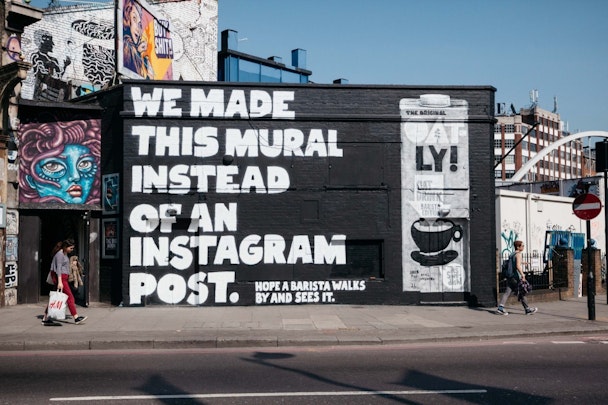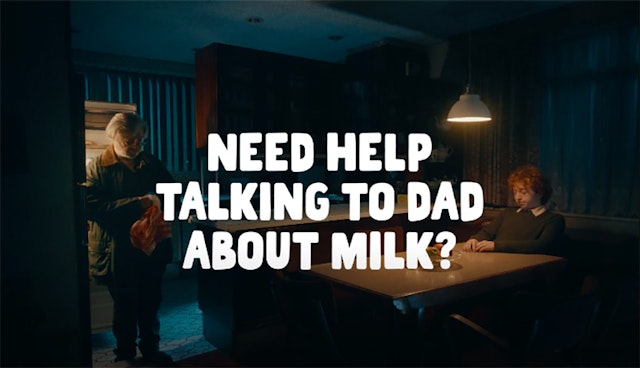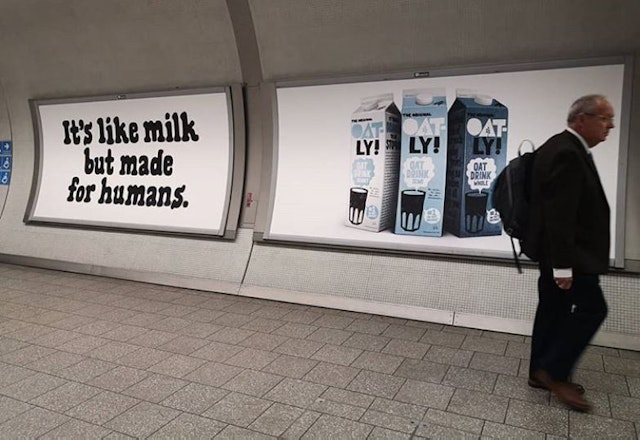Can Oatly protect its provocateur status as the suits swoop in?
Oatly has seen phenomenal growth and arguably established itself as the face of the alternative-milk category. Having nailed its branding, it secured over $441m in funding according to Interbrand’s Breakthrough Brands report. For its creative chief, the biggest worry now is whether he can preserve its bolshy ‘don’t overthink it’ approach as investors take a greater interest.

Oatly
Its ads give it the air of a startup, but Oatly has in fact been around since 1994. After two-decades of slow growth, Toni Petersson arrived at the oat drink company in 2014 as chief executive and immediately mapped a course that would see it rebrand, expand into multiple territories and eventually achieve a $1.4bn IPO.
Marketing has played no small role in this stratospheric rise. Setting the tone for its bold efforts of the past five years has been Michael Lee, who joined as creative director in 2017.
From goading the British dairy industry with ‘Like milk, but for humans’ ads to taking over every out-of-home site on a single street to make it “feel like it’s North Korean propaganda”, Lee is not afraid to take Oatly to the extremes in the name of provocation.
The creative is youthful, messy even, but the statements around purpose have been clear and bold. “It’s always been part of our DNA to be fearless,” says Lee.
“If you have a mission to change the food system, you can’t do that without stepping on some people’s toes and being provocative. And I think a lot of our strength comes from not overthinking things. If we did think things through, we probably wouldn’t do them.”
He describes Oatly has having a “courageous naiveite”. It does everything to further its mission to have the world drinking dairy alternatives – and if that gets it into trouble, then so be it. Indeed, its ad ’Help Dad’ saw it accused of ageism after its “snarky” efforts to highlight the damaging environmental impact of the dairy sector. The campaign may be challenging, it responded, but it will not apologize for doing what it needs to get the point across. That same campaign also drew the ire of the Advertising Standards Association, which forced it to make alterations after complaints its green claims were misleading.
“The first ones over the trench always get shot. We get shot a lot, which only means we hire a lot of lawyers,” laughs Lee.

Naeiri Zargarian, the strategy director at Interbrand, describes the brand as “anti-establishment” and “unconventional”, likening its approach to Ben & Jerry’s in the ice cream category or Brew Dog in craft beer.
“It uses the power of a fearless, self-aware personality and progressive values to challenge the status quo in its category and culture at large,” she says. ”Built on the fact that most of the world’s population is lactose-intolerant, Oatly came out of the gates challenging the dominance of the dairy industry – not only from a health perspective but on sustainability metrics as well.”
To get its message out it has targeted high-end coffee shops, which has proven a shrewd marketing, turning baristas into fans.
Lee says he categorically doesn’t have a “media strategy” and is happy to dabble in a bit of everything when it comes to advertising, be that digital, TV or even a YouTube series fronted by puppets. But time and again Oatly has turned to large-scale OOH activations, which have appeared everywhere from London to LA to Times Square in New York. It would seem big billboard ads are the not-so-secret marketing tactic of this fast-growth brand.
“It’s one of the last mediums that you can’t turn it off or look for look away from,” explains Lee.
“You can turn the TV off, you can not look at your phone, but it’s a proven fact that you cannot not read something. And when we talk about our brand, we often talk about being this voice that talks to people. It’s that same voice that’s everywhere. And out-of-home is now and public. It’s the modern-day equivalent of the guys getting up on a soapbox is in the 1800s. There’s just a scale that you can’t duplicate on mobile.
“And the fact that we [the creative team] are all, like, kind of middle aged, it’s just fun to see our stuff huge.”

That creative team Lee refers to would be the uniquely named ‘Department of Mind Control’, its in-house agency of 45 people that has handled the creative direction of the brand.
“Everything we do just kind of straddles the line between smart and stupid and naming our in-house creative department the Department of Mind Control… well, maybe it doesn’t sound smart but it certainly sounds stupid. But essentially, it’s also just about being transparent, you know? All of us in advertising, that’s exactly what we do, we try to manipulate and control people’s thoughts. So let’s be honest about that and be transparent on it.”
Despite Oatly’s massive growth and the international demands being put on that division, Lee says handling everything in-house except media buying continues to produce the best work for the brand.
Staff within in-house agencies are often on the receiving end of criticism that the very nature of only working on one brand, one idea, will ultimately hinder their creativity. But Lee stresses his team rival those in the greatest agencies in Europe. “There’s a certain depth that you get once you are working with one brand for several years; you reach a place that just has a uniqueness to it. And that comes through in the brand’s voice.
“So with a lot of our suppliers and partners we’ve worked with, it takes a while for them to get what we’re going after because we tend to dismiss all the rules and regulations of marketing. And that can often take a while for people to get used to.”
Dismissing the marketing rule book has worked so far. Oatly’s revenue for the first half of 2021 was up 59.4% to $286.2m, with profits for the period rising from $58.1m in 2020 to $80.5m. Oatly said it anticipated 2021 revenues to exceed $690m. Meanwhwile the oat milk category has exploded – from design-centric, small brands such as Minor Figures to major players like Califia Farms or Chobani. Despite the ever-present threat of competition eroding its market share, Lee won’t be changing tactics anytime soon and will continue to position it as the challenger brand… even if it’s now the one being challenged.
“The natural tendency is to try to adopt a more competitive kind of mindset, like: ’Oh, how do we make all these stand out against, you know, this brand or that brand?’ But I think that the best thing we can do is stick to our guns. We are the brand that does provocative stuff. We are the brand that isn’t afraid to take the issues on and then take the heat for it. And as soon as we stop doing that, we just become wallpaper. We just become another oat milk brand out there.”
Oatly has moved into other dairy products with its ice-creams and yogurts, and it is hinting at ambitions to become a bigger player in plant-based foods at large.
Interbrand’s Zargarian says: “Like many high-growth companies, it will need to continue to reaffirm its core values and product superiority even as it scales. These are make-or-break years – balancing the tension between the pressure for growth and the responsibility of keeping the soul of this spunky brand.”
It’s easier said than done, though. With the significant investment it has taken and its floating on the stock market, Oatly’s chief Petersson now has shareholders to answer to. Oatly’s biggest shareholder are Verlinvest and Blossom Key Holdings as well as private equity firm Blackstone which took a $200m stake in 2020.
Petersson is a loud supporter of the marketing direction, says Lee, but Oatly’s work is coming under greater scrutiny from all corners. The marketer's biggest challenge is to convince its serious corporate backers that its plucky upstart strategy will continue to deliver, and to trust his ad-hoc 'no-plan' process.
And the problem for him – much like external advertising agencies – is these outsiders just don’t know the ‘Oatly way’ of doing things yet.
He likens it to a spaceship that’s come over Oatly’s headquarters, “beaming down all of these consultants and people who talk about ROI and KPIs and all this stuff that you need to run a global business“.
“Maintaining our startup mentality takes a lot of work. We fight a lot of battles externally with all of our naysayers, all of our legal issues, all of our provocations in the market. But as a department, we’re also fighting a lot of those battles internally now because not everyone has the has the depth of understanding of where the brand came from.”
Stephen Mai is the former chief marketing officer for LadBible. He held senior marketing roles at Asos, Vice and Boiler Room during their formative years. He says that as Oatly hunts further growth in the coming years, a shake-up of its marketing could actually serve it well. “It does feel dated now. Big statements and funny lines appear gimmicky after a while and as more competitors come on board, its point of difference becomes less clear and apparent.
“What’s key now is diversification of product and adding value to the brand beyond a milk alternative. It needs to think about how else it is driving impact aligned with customer values and about what else it can do to culturally to make consumers’ lives better. Emotional connection is important here, especially considering how many consumers experience the product through their coffee shops rather than directly. Advertising is effective to land a message too, but impactful experiences and deeper interactions are required to build emotional connection and advocacy.”
For more Marketing Secrets of Fast-Growth Brands, check out The Drum’s latest Deep Dive.

